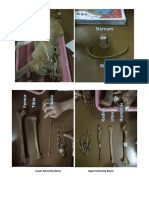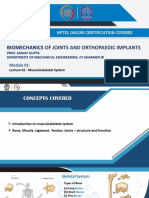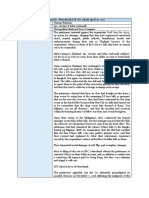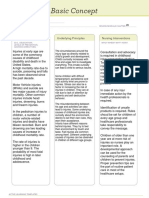Axial Bones: Calcium Carbonate Calcium Phosphate
Axial Bones: Calcium Carbonate Calcium Phosphate
Uploaded by
Junior Jr GamesCopyright:
Available Formats
Axial Bones: Calcium Carbonate Calcium Phosphate
Axial Bones: Calcium Carbonate Calcium Phosphate
Uploaded by
Junior Jr GamesOriginal Description:
Original Title
Copyright
Available Formats
Share this document
Did you find this document useful?
Is this content inappropriate?
Copyright:
Available Formats
Axial Bones: Calcium Carbonate Calcium Phosphate
Axial Bones: Calcium Carbonate Calcium Phosphate
Uploaded by
Junior Jr GamesCopyright:
Available Formats
Human Bones Effect of Fitness on Bone
a. When bones are subjected to regular physical
- Bone is very strong for its relatively light weight activity and habitual loads, they tend to become
denser and more mineralized
Bone Composition
Ex. Right forearm of the right-handed tennis player is
denser than her left one from using it more
The major components of bone are:
frequently
Calcium carbonate Calcium phosphate b. Inactivity works in the opposite direction, leading to a
- Make up 60-70% of bone weight decrease in weight and strength.
- Provide much of the bone’s stiffness and
Ex. Loss of bone mass has been noted in bed-ridden
resistance to pressing or squeezing forces
patients, inactive senior citizens, and astronauts
Collagen
- Gives bone its characteristic flexibility and
contributes to its ability to resist pulling and Axial Bones
stretching forces
- With aging, collagen is lost progressively and
bone becomes
Water
- Bone consists of much smaller proportion of water
than other body parts
Bone Classification: According to Porosity
Cortical bone (low porosity)
Spongy or cancellous bone (high porosity) 2 Parts of the Skull
Cancellous Bone Compact Bone Calvaria (Frontal, Parietal, Occipital, Temporal)
Face (Lacrimal, Nasal, Zygomatic, Maxilla, Mandible)
Low
High
High mineral Calvaria Bones
Porosity Low mineral content
content and low
and high collagen
collagen - May be fractured in blows to the skull (Ex. In
hockey, being checked and hitting the skull on
Honey comb Compact the ice)
Structure
Provides more Stiffer and can
Characteristics flexibility but is not resist greater stress
- Temporal bone:
as stress resistant but less flexible
a. more fragile of the
Withstanding calvaria bones
Shock Absorption
Due to its better
Stress b. overlies one of the major
Function In body areas that
ability to change blood vessels
are subject to higher
shape are important
impact loads c. if fractured and
displaced internally =
Long bones
medical emergency
Location Vertebrae Bones of the arms
and legs
Facial Bones
Vertebral Column Sternum
• Mid-line breast bone
• The clavicles and ribs one to seven articulate with
the sternum.
Vertebrae are arranged in a cylindrical column
interspersed with fibrocartilaginous (intervertebral) discs Appendicular Bones
Function: The pectoral girdle (chest)
Pelvic girdle (hip)
Provides a strong and flexible support for the body
The upper limbs
and the ability to keep the body erect to the point
The lower limbs
of attachment for the muscles of the back.
Protect the spinal cord and nerves. Pectoral Gridle
Absorbs shock through the intervertebral discs
without causing damage to other vertebrae.
Ribs
Made up of :
a. Bone
b. Cartilage - strengthen the chest cage and
permit it to expand.
All 12 pairs of ribs articulate with the twelve thoracic
vertebrae posteriorly. Consists of:
Classified into three groups based on anterior Scapula (shoulder blade)
attachment: Clavicle (collar bone)
a. True Ribs - attach to both the vertebrae and the
sternum (1-7) – Allows the upper limb great mobility.
b. False Ribs - attach only to the sternum indirectly,
– The sternoclavicular joint is the only point of
through 7th rib (8-10)
c. Floating Ribs - only attach to the vertebral column attachment between the axial skeleton and the
(11-12) pectoral girdle.
Pelvic Girdle Tibia and Fibula
• Formed by pair of os coxae (hip bones) - leg bones
- From knee to ankle
• Supports the bladder and - Tibia is medial and fibula is lateral
abdominal contents
Medial malleolus and Lateral malleolus
• Attachment:
- Posteriorly – join with the - The distal ends of the tibia and fibula, respectively
sacrum - Commonly referred to as the "ankle bones"
- Anteriorly - join to each - Can be easily palpated
other anteriorly
- Laterally – join to the head of
thigh bone through a cup-shaped acetabulum
Upper Limbs
• Humerus
- The arm bone
- Shoulder to elbow
• Radius and Ulna
- The forearm bones
- Elbow to wrist
- The radius being
located on the thumb
Tarsals
side of the hand
- ankle bones
- When you pronate
- calcaneus or the heel bone
the forearm, the
- talus
radius is actually
crossing over the ulna
Metatarsals
- 5 bones of the foot
- unite with the toes
Phalanges
- toe bones
- three per toe except the big toe - proximal,
middle and distal
Lower Limbs
Femur
- thigh bone
- from hip to knee
Patella
- knee cap
- sesamoid bone in the tendon of
the quadriceps muscles
(thigh)
You might also like
- Anatomy - & - Physiology Cheat SheetDocument2 pagesAnatomy - & - Physiology Cheat SheetAlaka71% (21)
- BTEC Sport Level 3 Revision Guide Skeletal SystemDocument23 pagesBTEC Sport Level 3 Revision Guide Skeletal SystemMP100% (3)
- Harris - Harris - The Radiology of Emergency Medicine, 5th EditionDocument1,050 pagesHarris - Harris - The Radiology of Emergency Medicine, 5th EditionMadalina Talpau100% (3)
- Brunnstorm StageDocument3 pagesBrunnstorm StageN ANo ratings yet
- Skeletal System - KODocument1 pageSkeletal System - KOGift Munyinda (G-Man)No ratings yet
- Sports Science Study (Topics 1 - 6)Document39 pagesSports Science Study (Topics 1 - 6)Jayden OoiNo ratings yet
- Biomechanics of Bone and Skeletal SystemDocument11 pagesBiomechanics of Bone and Skeletal SystemArun KumarNo ratings yet
- UNIT 4 Human MovementDocument18 pagesUNIT 4 Human Movementneoorivera6No ratings yet
- Skeletal System (Bones)Document5 pagesSkeletal System (Bones)Erica BobadillaNo ratings yet
- Muscle and Skeletal FunctionDocument23 pagesMuscle and Skeletal FunctionLuan NguyenNo ratings yet
- Human-Movement LecturesDocument5 pagesHuman-Movement LecturesCharianne Mae Vailoces YanocNo ratings yet
- Mod 1.2 Musculoskeletal System UpdatedDocument26 pagesMod 1.2 Musculoskeletal System UpdatedNandhkishoreNo ratings yet
- 6.2 Bone Classification - Anatomy & PhysiologyDocument10 pages6.2 Bone Classification - Anatomy & Physiologydhaliashekhar75No ratings yet
- Mc2 Chapter 7Document9 pagesMc2 Chapter 7Cassandra AguiluchoNo ratings yet
- Human BonesDocument39 pagesHuman Bonesmuhammad ijazNo ratings yet
- Bone ClassificationDocument5 pagesBone Classificationcharmcast9No ratings yet
- LEC Orthopedic NursingDocument31 pagesLEC Orthopedic NursingAlthea Franz DuoNo ratings yet
- Health Assessment-Finals: Assessing Musculoskeletal SystemDocument12 pagesHealth Assessment-Finals: Assessing Musculoskeletal Systemelena ampatinNo ratings yet
- Mata Kuliah Anatomi Dan Fisiologi "Sistem Gerak"Document50 pagesMata Kuliah Anatomi Dan Fisiologi "Sistem Gerak"Fardian AkbarNo ratings yet
- Anatomical Reference Planes: Human Bone Growth and DevelopmentDocument12 pagesAnatomical Reference Planes: Human Bone Growth and Developmentapi-3825389No ratings yet
- CH 04Document45 pagesCH 04Mohamed SalahNo ratings yet
- Chapter 5 - SKELETALSYSTEMDocument22 pagesChapter 5 - SKELETALSYSTEMGuenNo ratings yet
- CSEC Human and Social Biology - The Skeletal SystemDocument10 pagesCSEC Human and Social Biology - The Skeletal SystemSamantha Thomas100% (1)
- Human Anatomy & Physiology of Hip JointDocument4 pagesHuman Anatomy & Physiology of Hip JointZed P. EstalillaNo ratings yet
- General Anatomy: 1. SupportDocument4 pagesGeneral Anatomy: 1. SupportNu Ri LeeNo ratings yet
- SL REVISION Topic 1 & 2Document27 pagesSL REVISION Topic 1 & 2Muffaddal MustafaNo ratings yet
- SKELETAL AND MUSCULAR SYSTEM (Physiology)Document11 pagesSKELETAL AND MUSCULAR SYSTEM (Physiology)arialix2704No ratings yet
- Classifications of Bones: Gross AnatomyDocument6 pagesClassifications of Bones: Gross AnatomyArchie CabacheteNo ratings yet
- AK vs TK Table CorrectedDocument1 pageAK vs TK Table CorrectedM.D.B.H SpersNo ratings yet
- Hueso 2Document16 pagesHueso 2gianluca.franceschini38No ratings yet
- Skeletal System Skeletal Anatomy: (Typical)Document10 pagesSkeletal System Skeletal Anatomy: (Typical)anon_660872041No ratings yet
- Week 5 Skeletal SystemDocument10 pagesWeek 5 Skeletal SystemKimberly Faye JuevesNo ratings yet
- Mc 1 - Anaphy (Skeletal System)_032311Document4 pagesMc 1 - Anaphy (Skeletal System)_032311armada.ralphlawrenceNo ratings yet
- RT 105 Midterm NotesDocument17 pagesRT 105 Midterm NotesLouiseNo ratings yet
- HuesoDocument40 pagesHuesosandra FTNo ratings yet
- ARMONIA ALEXA JOIE C. BSN 1B Manual Skeletal SystemDocument7 pagesARMONIA ALEXA JOIE C. BSN 1B Manual Skeletal SystemJohanna Marie GantalaoNo ratings yet
- 1.1 The Skeletal SystemDocument10 pages1.1 The Skeletal SystemPaulaNo ratings yet
- The Skeletal System Education Presentation in Green Yellow Simple Outlined - 20240819 - 074053 - 0000Document20 pagesThe Skeletal System Education Presentation in Green Yellow Simple Outlined - 20240819 - 074053 - 0000James Van CasocotNo ratings yet
- Skeletal SystemDocument24 pagesSkeletal Systemrheanna0076No ratings yet
- Introduction To Musculoskeletal Anatomy: Ib SehsDocument34 pagesIntroduction To Musculoskeletal Anatomy: Ib SehsMaggie-Louise BellamyNo ratings yet
- Biomechanics ReviewerDocument12 pagesBiomechanics ReviewerJOHN EVAR LABASTILLANo ratings yet
- The Skeletal System: Function PreviewDocument24 pagesThe Skeletal System: Function PreviewkanekiNo ratings yet
- HSB Section Skeletal SystemDocument15 pagesHSB Section Skeletal SystemVanya ParsonsNo ratings yet
- Chapter 6 Skeletal SystemDocument5 pagesChapter 6 Skeletal SystemCriscia Lene OlatNo ratings yet
- The Skeleton SystemDocument20 pagesThe Skeleton SystemRea LamparasNo ratings yet
- Bone LectureDocument50 pagesBone LectureHenry Rodríguez GuzmánNo ratings yet
- The - Skeletal - System Lab ActDocument13 pagesThe - Skeletal - System Lab ActmendozakaceeyNo ratings yet
- The Skeletal System Education Presentation in Green Yellow Simple Outlined StyleDocument44 pagesThe Skeletal System Education Presentation in Green Yellow Simple Outlined StyleWilson Pagaduan Langcay JuniorNo ratings yet
- Ncm 116 Lect MidtermsDocument24 pagesNcm 116 Lect Midterms362118No ratings yet
- CHAP 5 The Skeletal SystemDocument47 pagesCHAP 5 The Skeletal SystemJoforce Karl MalanaNo ratings yet
- BONES Pointers MIDTERMDocument6 pagesBONES Pointers MIDTERMRumochiiNo ratings yet
- Chapter 6 ANAPHY Skeletal SystemDocument6 pagesChapter 6 ANAPHY Skeletal Systemrobh0026No ratings yet
- Week 9 Revised Ap1 Lecture Joints V24-25Document39 pagesWeek 9 Revised Ap1 Lecture Joints V24-25ks32016No ratings yet
- Chapter 6 Skeletal SystemDocument10 pagesChapter 6 Skeletal SystemJohn Benedict Sta AnaNo ratings yet
- Unit 4Document26 pagesUnit 4sivexgamingNo ratings yet
- Biomech Ch2 2015Document147 pagesBiomech Ch2 2015Guruprasad KancharlaNo ratings yet
- 2.osteology FormattedDocument45 pages2.osteology FormattedSling100% (1)
- 1-Upper LimbDocument37 pages1-Upper LimbArop AchierNo ratings yet
- PE-11-UNIT-4Document20 pagesPE-11-UNIT-4cesarolacojrNo ratings yet
- Ana - Joints ClassificationsDocument12 pagesAna - Joints ClassificationsMahmoud hilmyNo ratings yet
- Movement in HumansDocument35 pagesMovement in HumansLakeysha AlauraNo ratings yet
- Bone Grafts and Bone Graft Substitutes in Orthopaedic Trauma SurgeryDocument10 pagesBone Grafts and Bone Graft Substitutes in Orthopaedic Trauma SurgeryJay ChaNo ratings yet
- A Systematic Review of The Psychological Factors Associated With Returning To Sport Following InjuryDocument11 pagesA Systematic Review of The Psychological Factors Associated With Returning To Sport Following InjuryElena AlonsoNo ratings yet
- Hypovolemic Shock: An OverviewDocument18 pagesHypovolemic Shock: An OverviewVitória PinhoNo ratings yet
- Carbonell v. Metrobank G.R. No. 178467 April 26, 2017 Case DigestDocument3 pagesCarbonell v. Metrobank G.R. No. 178467 April 26, 2017 Case DigestyourlazyunnieNo ratings yet
- Epidemiology of Injuries During Judo TournamentsDocument14 pagesEpidemiology of Injuries During Judo TournamentsNico Duran CostaNo ratings yet
- Placement of The Electrodes. - How To - I-Tech Medical DivisionDocument8 pagesPlacement of The Electrodes. - How To - I-Tech Medical Divisionthe anaNo ratings yet
- Lasam Vs SmithDocument2 pagesLasam Vs SmithPauline80% (5)
- BNS10203 - Project 1Document12 pagesBNS10203 - Project 1Aliana RosuriNo ratings yet
- Pathology: Osteoarthritis Pathology: OsteoarthritisDocument4 pagesPathology: Osteoarthritis Pathology: OsteoarthritisWaseem Khan AfridiNo ratings yet
- Tara's CH. 64 Arthritis and Connective Tissue DisordersDocument34 pagesTara's CH. 64 Arthritis and Connective Tissue DisordersTara McNeillNo ratings yet
- Marginal I ADocument678 pagesMarginal I AImanNo ratings yet
- Ortopedi FlyerDocument3 pagesOrtopedi FlyertuzlaakupunkturNo ratings yet
- 1-Physical Injuries 1Document73 pages1-Physical Injuries 1Fatzie MendozaNo ratings yet
- United States Department of The Interior: National Park ServiceDocument25 pagesUnited States Department of The Interior: National Park ServiceChau HaiNo ratings yet
- Chronic Electrical Nerve Stimulation As A Therapeutic Intervention For Peripheral Nerve RepairDocument6 pagesChronic Electrical Nerve Stimulation As A Therapeutic Intervention For Peripheral Nerve RepaircontremonicaNo ratings yet
- JFK Autopsy Photographs: Warning This Material Contains Disturbing ImagesDocument25 pagesJFK Autopsy Photographs: Warning This Material Contains Disturbing Imagesbospangle100% (4)
- Comprehensive UL MM Table - Sheet1Document5 pagesComprehensive UL MM Table - Sheet1Teodora MunteanuNo ratings yet
- Revision - of - Surgery - by - Medad - Team سؤال و اجابه و حالات محلولهDocument45 pagesRevision - of - Surgery - by - Medad - Team سؤال و اجابه و حالات محلولهRehab EL NahasNo ratings yet
- Basic Concept - ATI Template Childhood InjuriesDocument1 pageBasic Concept - ATI Template Childhood InjuriesRafia HassanNo ratings yet
- Basic First AID: NSTP - CwtsDocument15 pagesBasic First AID: NSTP - CwtsBernadette Meriño MarchaNo ratings yet
- Anatomy L4 Gluteal RegionDocument40 pagesAnatomy L4 Gluteal RegionsmhhjjyNo ratings yet
- MST30 Semio EndoscopieDocument45 pagesMST30 Semio EndoscopietecodoNo ratings yet
- Repetative Task Task Design Risk Assessment 20240321 202043 0000Document53 pagesRepetative Task Task Design Risk Assessment 20240321 202043 0000Jason CamaNo ratings yet
- Unit 14Document4 pagesUnit 14Fitriana Noor SabrinaNo ratings yet
- Case Report Wobbler Syndrome (CVSM)Document9 pagesCase Report Wobbler Syndrome (CVSM)YraNo ratings yet
- Near Miss Management PolicyDocument7 pagesNear Miss Management PolicyKishan ChauhanNo ratings yet
- Syllabus For Paramedical CT Scan DiplomaDocument25 pagesSyllabus For Paramedical CT Scan DiplomaAllahabad UniversityNo ratings yet
- Department of Health and Human Services: S M Division OF Child Welfare LicensingDocument11 pagesDepartment of Health and Human Services: S M Division OF Child Welfare LicensingRiley MurdockNo ratings yet

























































































